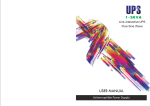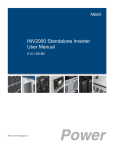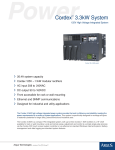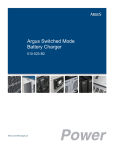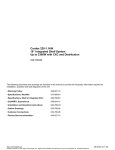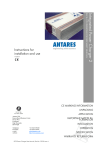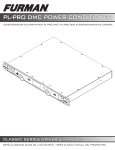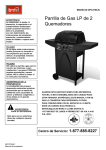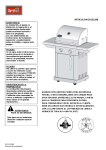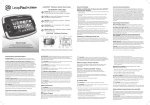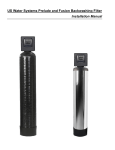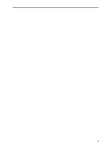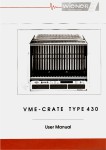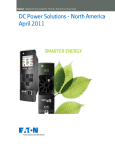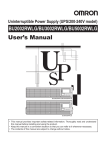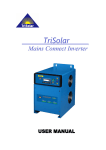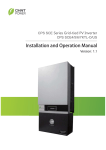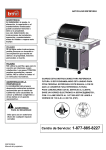Download User Manual - Performance Technology Solutions
Transcript
INEX Inverter System User Manual 014-114-B2 This page intentionally left blank. Argus Technologies Ltd. Burnaby, British Columbia. Telephone: 604 436 5900 Fax: 604 436 1233 Argus Technologies reserves the right to make changes to the products and information contained in this document without notice. Copyright 2008 Argus Technologies Ltd. Argus® is a registered trademark of Argus Technologies Ltd. All Rights Reserved. Printed in Canada. Visit www.argus.ca INEX Inverter System User Manual 014-114-B2 Applies to inverter modules 014-114-10, 014-115-10, 014-116-10, and 014-117-10. The following documents and drawings are included in this manual to provide the necessary information required for installation, operation and fault diagnosis of the unit: • Specifications: 014-114-B1 • Installation and Operation Instructions: 014-114-C0 • Factory Service Information: 048-527-10 Argus Technologies Ltd. 014-114-B2 Rev D WC Printed in Canada. © 2008 Argus Technologies Ltd. ARGUS and INEX are registered trademarks of Argus Technologies Ltd. All Rights Reserved. Specifications for INEX Inverter System Inverter Module Input Nominal Voltage: 48Vdc Operating Range: 40.5 to 58Vdc within rated limits Under Voltage Warning Threshold: 45Vdc Under Voltage Threshold: 40Vdc Over Voltage Warning Threshold: 58Vdc Over Voltage Threshold: 60Vdc Isolation AC-DC: Reinforced isolation (Pri-Sec) 4242Vdc/1min Inrush current: <2*Irated Isolation DC-enclosure: 707Vdc (varistors and filter capacitor removed)/1min Input Protection: Reverse polarity protection Psophometric Noise Voltage: ≤1.0mV ITU-T O.41 (16.66 to 6000Hz) Reflected Psophometric Noise Current: <1% according to YD/T 777-2006 Reflected Relative Band Width Current Noise: <10% (0-2MHz) according to YD/T 777-2006 Wide Band Noise: <1.0mV (psophometric, 25Hz to 5kHz) <20mVrms (25Hz to 20kHz) Peak to Peak Noise: <150mV up to 100MHz Inverter Module Output Power Capacity: 1000VA/800W, 1500VA/1200W Waveform: Pure sine wave Power Factor: 0.8 Nominal Output Voltage: 110/115/120Vac or 208/220/230/240Vac Voltage Regulation: Max ±2% Output Frequency: 50/60Hz Frequency Variation: Max ±0.5% Frequency Setting: Manually, field-selectable Crest Factor: 3:1 T.H.D. (Current): <3% for linear load, <5% for non-linear load Capacitive/Inductive Load: -0.8 to +0.8 without exceeding permissible distortion for resistive load Efficiency: Min 88% at rated load for 48Vdc system Argus Technologies Ltd. 014-114-B1 Rev D WC Printed in Canada. © 2008 Argus Technologies Ltd. ARGUS and INEX are registered trademarks of Argus Technologies Ltd. All Rights Reserved. Page 1 of 4 Specifications for INEX Inverter System Continued Current Limitation: Electronic current limitation at overloads and short circuits Isolation AC-enclosure: Basic isolation (Pri-Gnd) 2121Vdc/1min Surge Protection: EN61000-4-5, Telcordia GR-1089 CORE, ANSI/IEEE C62.41, STD 5871980 Dynamic Response: Better than ±10% according to IEC 62040-3 Class 1 Over Load Protection: 1.5*Inom >20s 1.25*Inom temperature controlled Inom = 1000VA/output voltage Short circuit current = 16A for INV-4810EA and 30A for INV-4810A Load Sharing: <5% Inverter Protection Over Load: When load exceeds 150% of power capacity, inverter will shut down after 20 seconds, and diagnose as overload fault with red LED lit. When load is 105~150%, inverter continuously delivers output power with a yellow LED lit for warning. Output Voltage Fault Detection: When the output RMS (root mean square) voltage is out of operating voltage range, the inverter unit will diagnose as output voltage high or low fault. Inverter Output Short Circuit: When output RMS voltage is below 40VAC and output RMS current is over 2A, the system will diagnose as inverter output short circuit fault with red LED on. Input Voltage Detection: When the DC input voltage is out of operating voltage range, the inverter system will shut down and release visual and audio alarms. Over Temperature: When inverter internal temperature rises over 100°C (212°F), the system will diagnose as over temperature fault with red LED flicker. Maximum Number of INEX Inverter Modules for Parallel Connection Model INV-4810A (1000VA/120Vac) INV-4810EA (1000VA/240Vac) INV-4815A (1500VA/120Vac) INV-4815EA (1500VA/240Vac) Note: Static transfer switch (STS) With STS-050A 6 12 4 8 Without STS-050A 12 12 8 12 INEX Controller Module DC Nominal Voltage: 48Vdc DC Voltage Range: 30 to 70Vdc Over Current Protection: 2A fuse LCD Display: 3” backlit LCD screen with 4 lines by 16 characters LED Indicators: Green/normal, yellow/warning, and red/fault Argus Technologies Ltd. 014-114-B1 Rev D WC Printed in Canada. © 2008 Argus Technologies Ltd. ARGUS and INEX are registered trademarks of Argus Technologies Ltd. All Rights Reserved. Page 2 of 4 Specifications for INEX Inverter System Continued Function Keys: Esc PgUp PgDn Enter for cancellation for cursor up movement for cursor down movement for selection of comment validation Buzzer: Audio alarm when inverter, STS, or controller module operates abnormally. Esc key cancels audible alarm. System Parameters: BaudRate – setting controller com port baud rate Keypad tones – setting keypad tones Time & Date – setting current time and date Setting Password – setting system password Brightness – setting LCD brightness Default – change current system parameters to default values Bat Calib – calibration battery voltage INEX Static Transfer Switch Module AC Input Voltage Range: 89 to 138Vac for 110/115/120Vac system 176 to 276Vac for 208/220/230/240Vac system Over Voltage Threshold: Adjustable between 117 and 127Vac for 110Vac system, default is 121Vac 122 and 132Vac for 115Vac system, default is 127Vac 127 and 138Vac for 120Vac system, default is 132Vac 220 and 240Vac for 208Vac system, default is 229Vac 233 and 252Vac for 220Vac system, default is 242Vac 244 and 264Vac for 230Vac system, default is 253Vac 254 and 276Vac for 240Vac system, default is 264Vac Under Voltage Threshold: Adjustable between 89 and 105Vac for 110Vac system, default is 99Vac 93 and 110Vac for 115Vac system, default is 104Vac 100 and 114Vac for 120Vac system, default is 108Vac 176 and 198Vac for 208Vac system, default is 187Vac 176 and 209Vac for 220Vac system, default is 198Vac 185 and 218.5Vac for 230Vac system, default is 207Vac 193 and 228Vac for 240Vac system, default is 216Vac Redundant Power Supply Design: Startup power-on by priority source or alternative Nominal Output Voltage: Same as utility voltage or inverter output Permissible Frequency Area: Max. ±2.5% (inverter synchronization) Transfer Time: Typical 1/4 cycle Rated Power: 50A Operation Methods: Inverter priority/Mains priority (On-line/Off-line) Argus Technologies Ltd. 014-114-B1 Rev D WC Printed in Canada. © 2008 Argus Technologies Ltd. ARGUS and INEX are registered trademarks of Argus Technologies Ltd. All Rights Reserved. Page 3 of 4 Specifications for INEX Inverter System Continued Mechanical Inverter Module: Dimensions: 43.8mm H x 215mm W x 270mm D [1.7" H x 8.5" W x 10.6" D] Weight: 2.5 kg (5.5 lb.) STS Module: Dimensions: 43.8mm H x 215mm W x 270mm D [1.7" H x 8.5" W x 10.6" D] Weight: 2.1 kg (4.6 lb.) Controller Module: Dimensions: 43.8mm H x 87.9mm W x 277mm D [1.7" H x 3.4" W x 10.8" D] Weight: 0.5 kg (1.1 lb.) Interface Module: Dimensions: 43.8mm H x 129.5mm W x 79.7mm D [1.7" H x 5.1" W x 3.1" D] Weight: 0.25 kg (0.55 lb.) Inverter Shelf: Dimensions: 43.8mm H x 440mm W x 329.5mm D [1.7" H x 17.3" W x 13" D] Weight: 2.7 kg (6 lb.) Controller/Interface/STS Shelf: Dimensions: 43.8mm H x 440mm W x 329.5mm D [1.7" H x 17.3" W x 13" D] Weight: 2.7 kg (6 lb.) MBSDU Panel: Dimensions: 88mm H x 483mm W x 329.5mm D [3.5" H x 19" W x 13" D] Weight: 7.0 kg (15.4 lb.) Environmental Operating Temperature: -20 to +70°C (-4 to +158°F) -5 to +50°C (23 to +122°F) with full performance Storage Temperature: -40 to +85°C (-40 to +185°F) Humidity: 0 to 90% non-condensing Heat Dissipation: Forced air cooling for inverter and STS modules Operating Altitude: 1500m (4922 feet) Audible Noise: 55dB ETS 300 753 Class 3.1 Standards Inverter Module: EN 60950-1, UL-60950-1, IEC 60950-1, CSA C22.2 No. 60950-1 STS Module: EN62040-1-1, IEC 62310-1, CSA C22.2 No. 107.3, ANSI/UL 1778 Controller Module: EN 60950-1 Marking: cULus, CE, RoHS, C-Tick The above information is valid at the time of publication. Consult factory for up-to-date ordering information. Specifications are subject to change without notice. Argus Technologies Ltd. 014-114-B1 Rev D WC Printed in Canada. © 2008 Argus Technologies Ltd. ARGUS and INEX are registered trademarks of Argus Technologies Ltd. All Rights Reserved. Page 4 of 4 IMPORTANT SAFETY INSTRUCTIONS SAVE THESE INSTRUCTIONS 1. Please read this manual prior to use to become familiar with the product’s numerous features and operating procedures. To obtain a maximum degree of safety, follow the sequences as outlined. 2. This manual provides warnings and special notes for the user: a. Points that are vital to the proper operation of the product or the safety of the operator are indicated by the heading: WARNING. b. A notation that is in Bold or Italic typeface covers points that are important to the performance or ease of use of the product. 3. Before using the product, read all instructions and cautionary markings on the product and any equipment connected to the product. 4. Do not expose the product to rain or snow; install only in a clean, dry environment. 5. CAUTION – Unless otherwise noted, use of an attachment not recommended or sold by the product manufacturer may result in a risk of fire, electric shock, or injury to persons. 6. CAUTION – Do not operate the product if it has received a sharp blow, it has been dropped, or otherwise damaged in any way – return it to a qualified service center for repair. 7. CAUTION – Do not disassemble the product – call our qualified service centers for servicing. Incorrect reassembling may result in a risk of electrical shock or fire. 8. WARNING – The input and output voltages of the product are hazardous. Extreme caution should be maintained when servicing or touching conductive components connected to the product. TABLE OF CONTENTS 1 INTRODUCTION ............................................................................................................................................................. 1 TU UT TU UT 1.1 1.2 1.3 2 Scope of the Manual ..................................................................................................................................... 1 Product Overview .......................................................................................................................................... 1 Model and Part Numbers .............................................................................................................................. 2 TU UT TU TU UT TU TU UT UT UT TU UT 2.1 2.2 3 Packing Materials .......................................................................................................................................... 3 Check for Damage ........................................................................................................................................ 3 TU UT TU TU UT TU UT UT SHELF INSTALLATION ................................................................................................................................................... 4 TU UT TU UT 3.1 3.2 3.3 4 Inverter Shelf Preparation/Mounting ............................................................................................................. 4 Controller/Interface/STS Shelf Mounting/Preparation................................................................................... 6 MBSDU Panel Mounting/Preparation ........................................................................................................... 7 TU UT TU TU UT TU TU UT UT UT TU UT WIRING AND CONNECTIONS .......................................................................................................................................... 8 TU UT TU UT 4.1 4.2 4.3 4.4 4.5 4.6 4.7 4.8 5 Safety Precautions ........................................................................................................................................ 8 Tools Required .............................................................................................................................................. 8 Wire Selection ............................................................................................................................................... 8 Single Inverter Shelf System ......................................................................................................................... 9 Multi-Inverter Shelf System ......................................................................................................................... 11 STS/Controller Shelf ................................................................................................................................... 14 Controller/Interface Shelf ............................................................................................................................ 15 MBSDU Panel ............................................................................................................................................. 17 TU UT TU TU UT TU TU UT TU UT TU UT TU UT TU UT TU UT UT UT TU UT TU UT TU UT TU UT TU UT TU UT MODULE INSTALLATION AND REMOVAL ....................................................................................................................... 20 TU UT TU UT 5.1 5.2 5.3 6 Installation and Removal of STS and Inverter Modules.............................................................................. 20 Controller Module Implementation .............................................................................................................. 21 Interface Module Implementation ................................................................................................................ 22 TU UT TU TU UT TU TU UT UT UT TU UT OPERATION ................................................................................................................................................................ 23 TU UT TU UT 6.1 6.2 6.3 6.4 7 Pre-Operation Check .................................................................................................................................. 23 Status Monitoring ........................................................................................................................................ 23 Parameter Setting ....................................................................................................................................... 25 Module Parameter Settings ........................................................................................................................ 26 TU UT TU TU UT TU TU UT TU UT UT UT TU UT TU UT DEFAULT VALUES ...................................................................................................................................................... 29 TU TU UT TU 8 UT UT MAINTENANCE ........................................................................................................................................................... 31 TU UT 8.1 8.2 8.3 9 UT TU INSPECTION.................................................................................................................................................................. 3 TU TU UT Inverter Fan Replacement .......................................................................................................................... 31 STS Fan Replacement ................................................................................................................................ 32 Replacement Parts...................................................................................................................................... 32 TU UT TU TU UT TU TU UT UT UT TU UT TROUBLESHOOTING.................................................................................................................................................... 33 UT TU UT 10 ARGUS CONVENTIONS ................................................................................................................................................ 37 TU UT TU UT 10.1 10.2 UT TU TU UT TU Numbering System...................................................................................................................................... 37 Acronyms and Definitions ........................................................................................................................... 37 TU UT UT 11 OUTLINE DRAWINGS ................................................................................................................................................... 38 TU UT TU UT 11.1 11.2 11.3 UT TU TU UT TU TU UT Mechanical Dimensions of INEX Inverter Module ...................................................................................... 38 Mechanical Dimensions of INEX STS Module ............................................................................................ 39 Mechanical Dimensions of INEX Controller Module ................................................................................... 40 TU UT UT TU UT i 11.4 11.5 11.6 11.7 UT TU TU UT TU TU UT TU UT Mechanical Dimensions of INEX Interface Module ..................................................................................... 41 Mechanical Dimensions of INEX Inverter Shelf .......................................................................................... 41 Mechanical Dimensions of INEX Controller/Interface/STS Shelf ............................................................... 42 Mechanical Dimensions of INEX MBSDU Shelf ......................................................................................... 43 TU UT UT TU UT TU UT ii 1 Introduction 1.1 Scope of the Manual This instruction manual explains the installation, interconnection, and operation of Argus Technologies’ INEX Inverter System. 1.2 Product Overview INEX inverter series is an integrated telecommunication AC power system, including inverter, static switch, LCD controller, and interface modules. With versatile “building block” design and N+1 redundant configuration, INEX inverter system facilitates complex telecommunication and industrial power demands. INEX series DC to AC inverter module is available for 1000VA (800W) or 1500VA (1200W) to convert -48Vdc input to 120Vac or 230Vac output at 50Hz or 60Hz. The inverter module is “hot swappable” meaning it can be inserted or removed from the shelf without cutting power to or from the system. A universal 19” shelf is designed to parallel connect and synchronize all INEX inverter models. With this shelf, INEX series employs N+1 redundant configuration to output power maximum of 12kVA for 120Vac models and 18kVA for 230Vac models, and to operate in N+1 redundant mode for optimization. INEX “all master” dynamic mechanisms automatically share and re-organize critical loads to further prevent interruption if one or more inverter modules fail. INEX selective static transfer switch (STS) provides automatic instantaneous load transfer, which further secures uninterrupted operation of sensitive electronic equipment. The INEX system controller, equipped with a DSP microprocessor, gives real-time system status through comprehensive LCD/LED indication, and allows program settings through the display panel. A communication interface module provides local or remote control and monitoring of the system. INEX Inverter system only INEX Inverter system with control/metering Illustrations only and may not match your installation. Argus Technologies Ltd. 014-114-C0 Rev D WC Printed in Canada. © 2008 Argus Technologies Ltd. ARGUS and INEX are registered trademarks of Argus Technologies Ltd. All Rights Reserved. Page 1 of 43 INEX Inverter system with STS and control/metering INEX Inverter system with STS, control/metering, and MBS/distribution Illustrations only and may not match your installation. INEX Inverter System features include: • • • • • • • • 1.2.1 Pure sine wave output with low distortion Versatile module design allows a variety of configurations for different power needs Easily expands capacity up to 18kVA with N+1 redundancy “All master” dynamic mechanism eliminates single-point failure to optimize reliability Hot-pluggable connection allows module addition or removal without cutting power Ultimate high power density reducing space demand High efficiency (> 88%) Comprehensive LCD/LED display provides system status, and user-friendly panel eases program settings. WinPower Software WinPower is a power management software specifically designed to monitor and control the INEX inverter system via a personal computer. It is available to download via the Argus website (www.argusdcpower.com). To remotely monitor and control INEX inverters, connect the USB cable (A-B type) to the port on the front panel of the interface module. Then follow instructions stated in the WinPower manual to properly install the software to a personal computer physically connected to the INEX inverter system. 1.3 Model and Part Numbers This product is available to order under the following part numbers: Model Number INV-4810A INV-4810EA INV-4815A INV-4815EA MC-1000A STS-050A MBSDU-50-2U-19A MBSDU-50-2U-19-UA MBSDU-50-2U-19A INVSS-2EA-1U-19A STSSS-I-1EA-1U-19A MC-BLANK IFC-BLANK INV-BLANK U S S Description Part Number 1000VA/800W inverter module (I/P: 48Vdc, O/P: 120Vac, 60Hz)......................014-114-10 1000VA/800W inverter module (I/P: 48Vdc, O/P: 230Vac, 50Hz)......................014-115-10 1500VA/1200W inverter module (I/P: 48Vdc, O/P: 120Vac, 60Hz)....................014-116-10 1500VA/1200W inverter module (I/P: 48Vdc, O/P: 230Vac, 50Hz)....................014-117-10 Controller module................................................................................................018-593-10 50A static transfer switch module .......................................................................019-050-10 Discontinued, see 020-424-10 ............................................................................020-417-10 MBS+DU panel (maintenance bypass switch and NEMA AC distribution) ........020-422-10 MBS+DU panel (maintenance bypass switch and IEC AC distribution).............020-424-10 Inverter shelf .......................................................................................................030-419-10 Controller/STS shelf (includes interface module IFC-1000NSA)........................030-420-10 Controller blank plate ..........................................................................................614-616-10 Interface blank plate............................................................................................614-617-10 Inverter/STS blank plate .....................................................................................614-618-10 S S The above information is valid at the time of publication. Consult factory for up-to-date ordering information. Argus Technologies Ltd. 014-114-C0 Rev D WC Printed in Canada. © 2008 Argus Technologies Ltd. ARGUS and INEX are registered trademarks of Argus Technologies Ltd. All Rights Reserved. Page 2 of 43 2 Inspection 2.1 Packing Materials All Argus products are shipped in rugged, double walled boxes and suspended via solid inserts to minimize shock that may occur during transportation. Packaging assemblies and methods are tested to International Safe Transit Association standards. Power systems are also packaged with Cortex. This plastic wrap contains a corrosive-inhibitor that protects the product from corrosion for up to two years. 2.1.1 Returns for Service Save the original shipping container. If the product needs to be returned for service, it should be packaged in its original shipping container. If the original container is unavailable, make sure the product is packed with at least three inches of shock-absorbing material to prevent shipping damage. NOTE: Argus Technologies is not responsible for damage caused by the improper packaging of returned products. 2.2 Check for Damage Prior to unpacking the product, note any damage to the shipping container. Unpack the product and inspect the exterior for damage. If any damage is observed contact the carrier immediately. Continue the inspection for any internal damage. In the unlikely event of internal damage, please inform the carrier and contact Argus Technologies for advice on the impact of any damage. Verify that you have all the necessary parts per your order for proper assembly. Argus Technologies Ltd. 014-114-C0 Rev D WC Printed in Canada. © 2008 Argus Technologies Ltd. ARGUS and INEX are registered trademarks of Argus Technologies Ltd. All Rights Reserved. Page 3 of 43 3 Shelf Installation This chapter is provided for qualified personnel to install the product. 3.1 Inverter Shelf Preparation/Mounting The inverter shelf has been designed for flush or mid-mounting in a 19” relay rack. Mounting brackets are also supplied for mounting in a 23” rack. NOTE: The shelf shall be mounted in a clean and dry environment. Allow at least 1.75” of free space in front of the unit for unrestricted cooling airflow. 1. There are four holes right above three deck connectors of each inverter slot. Based on inverter model, insert the supplied nylon guide pin to the corresponding hole: • • • • Position A for INV-4815A (as shown below) Position B for INV-4815EA Position C for INV-4810A Position D for INV-4810EA Nylon guide pins shown in Position A D D C B C B CAUTION System will fail to operate normally when inverter modules of different specifications are inserted into inverter shelves. Use supplied nylon guide pins for securing only inverter modules of the same specifications. Argus Technologies Ltd. 014-114-C0 Rev D WC Printed in Canada. © 2008 Argus Technologies Ltd. ARGUS and INEX are registered trademarks of Argus Technologies Ltd. All Rights Reserved. Page 4 of 43 2. The shelf should be mounted to the rack using at least two #12 – 24 x 1/2” screws in each bracket. Philips-type screws and screwdriver should be used to eliminate the possibility of slippage and scratching of the unit’s exterior. Washers (such as internal tooth) or special screws that are designed to cut through the painted surface should be used to ensure a good chassis ground. 3. Put the inverter shelf into the equipment rack horizontally, and align holes of mounting brackets and rack. 4. Each inverter shelf holds maximum two inverter modules. Repeat the steps above to install the inverter shelves as required. 5. All input and output connections are made through the knockouts, located in the top and the bottom of the shelf rear cover, as well as both side panels. Remove the rear cover to access the inverter shelf backplane and connectors. 6. Knockouts on top and bottom are for shelf inter-connections and supplementary wire routing. To remove knockout, snip tabs, move plate up and down until tabs in back snap apart. Argus Technologies Ltd. 014-114-C0 Rev D WC Printed in Canada. © 2008 Argus Technologies Ltd. ARGUS and INEX are registered trademarks of Argus Technologies Ltd. All Rights Reserved. Page 5 of 43 3.2 Controller/Interface/STS Shelf Mounting/Preparation The shelf has been designed for flush or mid-mounting in a 19” relay rack. Mounting brackets are also supplied for mounting in a 23” rack. NOTE: The shelf shall be mounted in a clean and dry environment. Allow at least 1.75” of free space in front of the unit for unrestricted cooling airflow. 1. The shelf should be mounted to the rack using at least two #12 – 24 x 1/2” screws in each bracket. Philips-type screws and screwdriver should be used to eliminate the possibility of slippage and scratching of the unit’s exterior. Washers (such as internal tooth) or special screws that are designed to cut through the painted surface should be used to ensure a good chassis ground. 2. Put the shelf into the equipment rack horizontally, and align holes of mounting brackets and rack. NOTE: Each INEX controller module or interface module allows maximum control of 12 inverter units cascaded. It is recommended to have the controller/interface/STS shelf installed on top of stacked inverter shelves to ease inter-connections; however, it may be installed below the inverter shelves if the MBSDU panel is not required. All input and output connections are made through the knockouts, located in the top and the bottom of each of the two rear covers, as well as both side panels. The cover on the right is for the controller/interface section, and the cover on the left is for the STS section. 3. Remove the rear cover(s) to access the shelf backplane and connectors. 4. Knockouts on top and bottom are for shelf inter-connections. To remove knockout, snip tabs, move plate up and down until tabs in back snap apart. Argus Technologies Ltd. 014-114-C0 Rev D WC Printed in Canada. © 2008 Argus Technologies Ltd. ARGUS and INEX are registered trademarks of Argus Technologies Ltd. All Rights Reserved. Page 6 of 43 3.3 MBSDU Panel Mounting/Preparation The panel has been designed for flush or mid-mounting in a 19” relay rack. Mounting brackets are also supplied for mounting in a 23” rack. NOTE: The panel shall be mounted in a clean and dry environment. 1. The panel should be mounted to the rack using at least two #12 – 24 x 1/2” screws in each bracket. Philips-type screws and screwdriver should be used to eliminate the possibility of slippage and scratching of the unit’s exterior. Washers (such as internal tooth) or special screws that are designed to cut through the painted surface should be used to ensure a good chassis ground. 2. Put the panel into the equipment rack horizontally, and align holes of mounting brackets and rack. The panel must be mounted above the controller/interface/STS shelf. 3. All input and output connections are made through the knockouts, located in the bottom of the rear cover and both side panels. To remove knockout, snip tabs, move plate up and down until tabs in back snap apart. 4. Remove the rear cover to access the backplane and connectors. Argus Technologies Ltd. 014-114-C0 Rev D WC Printed in Canada. © 2008 Argus Technologies Ltd. ARGUS and INEX are registered trademarks of Argus Technologies Ltd. All Rights Reserved. Page 7 of 43 4 Wiring and Connections This chapter provides notes on cable sizing and cabling details with respect to the Argus INEX 1000/1500 Inverter System. 4.1 Safety Precautions WARNING Ensure all power sources are OFF during wiring. Disconnect battery cables from battery. Before working with any battery or power system/distribution center, follow these precautions: • • Remove all metallic jewelry; e.g., watches, rings, metal rimmed glasses, necklaces. Wear safety glasses with side shields (and prescription lenses if necessary) at all times during installation. The installer should follow all applicable local rules and regulations for electrical and battery installations; e.g., CSA, UL, CEC, NEC, OSHA, and local fire codes. Use OSHA approved insulated hand tools. 4.2 Tools Required Various tools are essential for product installation. Use this list as a guide: • • • • • • • 4.3 Slot head screwdrivers (blade sizes: 1/4”, 1/8”, 1/16”) Philips head screwdriver, #2 (tip size 3/16”) Digital voltmeter equipped with test leads Adjustable 48Vdc load (optional) Cutters and wire strippers Crimping tool (optional for large gauge wire) Anti-static wrist strap. Wire Selection The INEX inverter modules are designed to operate in parallel for higher output current. Two modules are automatically connected in parallel in each shelf. Two or more inverter shelves can be further connected in parallel for additional output power; this is done by connecting inputs (BAT-, BAT+) in parallel, and outputs (Line, Neutral, Ground) in parallel. When paralleled, there is no master unit and each unit adjusts its own power level for best power sharing. Please refer to the following wiring instructions for your needs. When selecting wiring, consider the following factors: • • • Current carrying capacity of the wire Maximum wire length needed Maximum ambient temperature. Argus Technologies Ltd. 014-114-C0 Rev D WC Printed in Canada. © 2008 Argus Technologies Ltd. ARGUS and INEX are registered trademarks of Argus Technologies Ltd. All Rights Reserved. Page 8 of 43 NOTE: Use the following table as a guide only. Ensure that the installation complies with the specific wiring rules applicable to your country or area of jurisdiction. Shelf number of 2 x 1000VA inverter cascaded #1 #2 #3 #4 #5 #6 Shelf number of 2 x 1500VA inverter cascaded #1 #2 #3 #4 #5 #6 Input Current Maximum @ 40Vdc 45.5A 91.0A Input Current Maximum @ 40Vdc 68.2A 136.4A 110Vac Output Current Max. 230Vac Output Current Max. 18.2A 36.4A 54.5A 72.7A 90.9A 109.1A 8.7A 17.4A 26.1A 34.8A 43.5A 52.2A 110Vac Output Current Max. 230Vac Output Current Max. 27.3A 54.5A 81.8A 109.1A 136.4A 163.6A 13.0A 26.1A 39.1A 52.2A 65.2A 78.3A Minimum Size of DC Input Wire Max. Min. Size of 110Vac Output Wire Max. Min. Size of 230Vac Output Wire Max. #8 AWG #4 AWG #14 AWG #10 AWG #8 AWG #6 AWG #4 AWG #3 AWG #16 AWG #14 AWG #10 AWG #10 AWG #8 AWG #8 AWG Minimum Size of DC Input Wire Max. Min. Size of 110Vac Output Wire Max. Min. Size of 230Vac Output Wire Max. #6 AWG #2 AWG #12 AWG #8 AWG #6 AWG #3 AWG #2 AWG #2 AWG #16 AWG #12 AWG #10 AWG #8 AWG #6 AWG #6 AWG Table A–Recommended wire size versus current Remarks: 1. Total Power Rating (VA, W) = No. of shelf × Inverter module power rating (VA, W) * 2 2. I/P current = Total power rating (W) ÷ 0.88 ÷ 40 3. O/P current = Total power rating (VA) ÷ AC voltage 4.4 Single Inverter Shelf System 1. In the inverter shelf package, you will find a jumper. When only ONE inverter shelf is applied in the system, insert the jumper to pins 1 and 2 of connector JP2: 2. Negative (BAT-) and positive (BAT+) DC input terminal studs are located in the left side of backplane. In consideration of the power rating and distance from the battery, choose appropriate gauge wire using Table A as well as local wiring rules. NOTE: For inverter systems without a controller, open collector terminals are available on the inverter shelf backplane for the inverter fail alarm. See details under point 9 of Section 4.5. Argus Technologies Ltd. 014-114-C0 Rev D WC Printed in Canada. © 2008 Argus Technologies Ltd. ARGUS and INEX are registered trademarks of Argus Technologies Ltd. All Rights Reserved. Page 9 of 43 3. Thread battery cables through left-side panel knockout; put the hole lug at one end of each battery cable to DC input stud. 4. Secure the connection with two supplied M5x12 cross hexwasher type nickel screws and washers as shown: CAUTION Reverse polarity connections would damage the unit and is not cover by the warranty. Ensure correct polarity (positive to positive, negative to negative) before completing connections between battery and INEX inverter unit. 5. Install the other end of battery cables to battery or 48Vdc source. WARNING DC source voltage should be between 45V and 58V. 6. The three studs in the center of the backplane are AC output terminals. AC neutral, ground and line are marked as UC3, UC4 and UC5, respectively. Check the AC output voltage. Using Table A, as well as local wiring rules, choose appropriate gauge wire. 7. Thread AC neutral and line wires through left-side panel knock-out, put the hole lug at one end of each wire to AC neutral and AC line studs. 8. Secure the connection with two supplied M5x12 cross hex-washer type nickel screws and washers as shown. 9. Install the other end of wires to the AC distribution or load. 10. AC Ground stud (UC4) is mainly for inter-connection with extra shelves. To do system grounding, cover up the backplane with the rear cover first, and screw the ground wire on the rear cover with the supplied cross hex-washer type nickel screw as shown: DANGER To meet CEC/NEC requirements – to prevent fire, electric shock, improper operation of circuit protection devices, as well as improper operation of the equipment – an electrical bond between neutral and ground is required at the AC source or distribution point of an inverter system. Ensure that the installation complies with the specific wiring rules applicable to your country or area of jurisdiction. Argus Technologies Ltd. 014-114-C0 Rev D WC Printed in Canada. © 2008 Argus Technologies Ltd. ARGUS and INEX are registered trademarks of Argus Technologies Ltd. All Rights Reserved. Page 10 of 43 4.5 Multi-Inverter Shelf System CN20 and CN21 at the inverter shelf backplane are inter-parallel connectors for inverter synchronization. The upper port is used to connect the inverter shelf above, and the lower port is used to connect the inverter shelf below. 1. Use the flat communication cables provided to connect all available inverter shelves: 2. Use the supplied bus bars for connecting the DC negative input (BAT-) studs of all available shelves together with M5x12 cross hex-washer type nickel screws and washers. See Table A. 3. Similarly, connect DC positive input (BAT+) studs of all shelves together. 4. Do the same for AC neutral (UC3), AC ground (UC4) and AC line (UC5) studs individually: NOTE: Spacers supplied are required on the last (bottom) shelf for AC bars. CAUTION Ensure that no jumper is inserted into JP2 connector of all connected inverter shelves. 5. Choose appropriate gauge wire with consideration for the total input current of the whole inverter system, distance from the battery, and local wiring rules. 6. Thread two battery cables through left-side panel knockout, and attach one battery cable to one DC negative input stud (BAT-) and the other to one DC positive input stud (BAT+). CAUTION Reverse polarity connections would damage the unit and is not cover by the warranty. Ensure correct polarity (positive to positive, negative to negative) before completing connections between battery and INEX inverter unit. 7. Secure the connection with two supplied cross hex-washer type nickel screws and washers as shown. 8. Install the battery cables to battery or 48Vdc source. WARNING DC source voltage should be between 45V and 58V. Argus Technologies Ltd. 014-114-C0 Rev D WC Printed in Canada. © 2008 Argus Technologies Ltd. ARGUS and INEX are registered trademarks of Argus Technologies Ltd. All Rights Reserved. Page 11 of 43 9. For inverter systems without a controller, open collector terminals are available on the inverter shelf backplane for the inverter fail alarm. 10. Check the AC output voltage. Using Table A, as well as local wiring rules, choose appropriate gauge wire. 11. Thread selected AC neutral and line wires through left-side panel knockout, and attach one cable to one AC neutral (UC3) stud and the other to AC line (UC5) stud. 12. Secure the connection with two supplied M5x12 cross hex-washer type nickel screws and washers. 13. Install the other end of wires to the AC distribution or load. To connect the INEX inverter with an Argus Cordex™ system controller (CXC), use the contacts of CN11 on the INEX inverter shelf to connect to any available digital input on the CXC. See the following example: Argus Technologies Ltd. 014-114-C0 Rev D WC Printed in Canada. © 2008 Argus Technologies Ltd. ARGUS and INEX are registered trademarks of Argus Technologies Ltd. All Rights Reserved. Page 12 of 43 14. To do system grounding, cover up the backplane with the rear cover first, and screw the ground wire on the rear cover with the supplied cross hex-washer type nickel screw as shown: NOTE: INEX inverter modules allow maximum 12 units cascaded for expanding power capacity. The input current of entire inverter system would exceed the current limit of available wires. When the total input current is over the cable current limit, split DC connection to multiple groups by removing inter-connected BAT+ & BAT- bus bars between groups, and choose suitable wire size for each group. Input DC feeder breaker configured one per shelf or optionally input breaker per two shelves maximum. 4.5.1 CASE STUDY – An inverter system with eight INV-4810A inverter modules (8kVA) The total input current, 151.5A @ 48Vdc, can be halved by removing DC positive (BAT+) and DC negative (BAT-) bus bars connected between shelves 2 and 3. DC connection is split into two groups (4kVA and 4kVA). After selecting suitable wire for minimum transmission current of 75.8A, two pairs of battery cable are separately connected to DC positive and negative studs of both groups as shown: Argus Technologies Ltd. 014-114-C0 Rev D WC Printed in Canada. © 2008 Argus Technologies Ltd. ARGUS and INEX are registered trademarks of Argus Technologies Ltd. All Rights Reserved. Page 13 of 43 4.6 STS/Controller Shelf WARNING Ensure all power sources are OFF during wiring. Disconnect battery cables from battery. 1. Follow wiring instructions to suit your installation. CN1: Use shorting plug for pins 1 to 4 when MBS is not installed CN2: SYNC port on the controller/interface shelf backplane 2. Locate the CN2 connector on the backplane of the STS shelf and the CN7 connector on the backplane of the inverter shelf. Connect these two connectors with the attached STS signal cable as shown: CN7: SYNC port on the inverter shelf backplane 3. Connect AC bus connectors of STS shelf to the AC bus of the top level inverter shelf. 4. Then connect the AC bus connectors between inverter shelves. NOTE: Spacers supplied are required on the last (bottom) shelf for AC bars. 5. Route both DC input wires through the wire hole on the left side of the inverter shelf. Use the cross-pan type nickel screws in accessory kit for fixing both DC input wires. CAUTION To connect AC output wires onto the system, only one AC line and AC neutral are necessary to be connected either from STS shelf or inverter shelf. 6. For inverter shelf only or without STS module: Connect AC LINE to the UC4 (AC-L OUT) connector of STS shelf. Connect AC NEUTRAL LINE onto UC3 (AC-N) connector of STS shelf. This page Next page 7. With STS module: Connect AC LINE IN to UC5 and AC LINE OUT to UC4 of STS shelf. Connect AC NEUTRAL IN/OUT to UC3. Argus Technologies Ltd. 014-114-C0 Rev D WC Printed in Canada. © 2008 Argus Technologies Ltd. ARGUS and INEX are registered trademarks of Argus Technologies Ltd. All Rights Reserved. Page 14 of 43 4.7 Controller/Interface Shelf WARNING Ensure all power sources are OFF during wiring. Disconnect battery cables from battery. 1. INEX controller and interface modules are powered from inverters. Securely plug one end of the supplied 3pin power cable to CN12 power jack on the controller/interface/STS shelf backplane, and the other end to CN9 power jack on the inverter shelf backplane: CN12: Power connector of controller CN9: Power connector to controller 2. CN3 connector on the controller/interface shelf backplane, and CN8 connector on the inverter shelf backplane are for data transferring between controller/interface modules and inverters. Use the supplied signal cable to link the two connectors together as shown: CN3: CAN COM port on the controller/interface shelf backplane CN7 to CN11 relay alarm contacts (1A rated) [see below] CN8: CAN COM port on the inverter shelf backplane Argus Technologies Ltd. 014-114-C0 Rev D WC Printed in Canada. © 2008 Argus Technologies Ltd. ARGUS and INEX are registered trademarks of Argus Technologies Ltd. All Rights Reserved. Page 15 of 43 3. Use #30 to 16AWG to connect dry contact terminal CN7 to CN11: NOTE: To set the alarm mode of dry contact, refer to the next chapter. 4. Replace rear cover(s) once all connections have been completed. Argus Technologies Ltd. 014-114-C0 Rev D WC Printed in Canada. © 2008 Argus Technologies Ltd. ARGUS and INEX are registered trademarks of Argus Technologies Ltd. All Rights Reserved. Page 16 of 43 4.8 MBSDU Panel 1. Connect signal cables between MBSDU panel, STS and inverter shelves as shown: 2. Remove the shorting plug on CN1 and connect the 4-pin MBS cable to the CN1 connector on the backplane of the STS shelf. #4 (AC I/P) #1, #1, #2 3. Connect the 5 bus bars supplied with the MBSDU panel to the STS backplane via the corresponding connectors of MBSDU panel as shown: #3 (STS O/P) DANGER To meet CEC/NEC requirements – to prevent fire, electric shock, improper operation of circuit protection devices, as well as improper operation of the equipment – an electrical bond between neutral and ground is required at the AC source or distribution point of an inverter system. Ensure that the installation complies with the specific wiring rules applicable to your country or area of jurisdiction. For INEX systems with a MBSDU, this can be facilitated by installing a wire jumper between Neutral and Ground on the terminal block labelled “output” on the back of the MBSDU shown here: 4. Connect AC input to the terminal on the back left of MBSDU panel according to the position of the labels as shown. Wire jumper should be sized for the maximum capacity of the system. Refer to Table A. 5. Connect AC output to the terminal (according to the label) on the back right of MBSDU panel to external distribution or load. Argus Technologies Ltd. 014-114-C0 Rev D WC Printed in Canada. © 2008 Argus Technologies Ltd. ARGUS and INEX are registered trademarks of Argus Technologies Ltd. All Rights Reserved. Page 17 of 43 6. Replace rear cover(s) once all connections have been completed. 7. Screw the system ground wire on the rear cover with the supplied cross hex-washer type nickel screw. CAUTION STS is not hot swap without MBS. When installing STS module with MBS it is not necessary to turn off the system. However, the incorrect install/removal action will damage the STS module frame because of the safety lock of the MBS. Proceed as follows: put switch at MBP or IBP position (Determined by mains and inverter output status) as shown: MBP position: 4.8.1 IBP position: Position Status of MBS The operation mode of STS is closely associated with the position of MBS. The MBS has two main connectors and three assistant connectors. The signals generated by three assistant connectors are passed to DSP for position status detection. There are five valid positions: 1. 2. 3. 4. 5. MBP – mains bypass MSS – mains static switch (for mains maintenance) NORM – normal operation ISS – inverter static switch (for inverter maintenance) IBP – inverter bypass U U U U U U U U U U U U U U U U U U U U U U U U U U STS will continuously detect the position of MBS in order to decide the transferring action between different modes. When the STS is powered on, it will judge whether the present position of MBS is valid. If the status is invalid, STS will consider MBS not well connected, and it will not enter any types of operation mode until the detection signal becomes normal. If MBS is changed when STS runs at one of the five valid positions, and this change happens between two adjacent positions, the STS will transfer to different mode based on current status. Otherwise, the STS will not take any action. For example, if MBS is set at P3, STS will take action when MBS is turned to P2 or P4. Argus Technologies Ltd. 014-114-C0 Rev D WC Printed in Canada. © 2008 Argus Technologies Ltd. ARGUS and INEX are registered trademarks of Argus Technologies Ltd. All Rights Reserved. Page 18 of 43 NOTE: Be sure not to change MBS position immediately when STS is inserted into the rack, wait at least five seconds if you want to change it. When you change its position you must confirm that you keep MBS at one position more than one second in order for MCU of STS has enough time to detect MBS position via MBS auxiliary contacts (CN1). Argus Technologies Ltd. 014-114-C0 Rev D WC Printed in Canada. © 2008 Argus Technologies Ltd. ARGUS and INEX are registered trademarks of Argus Technologies Ltd. All Rights Reserved. Page 19 of 43 5 Module Installation and Removal 5.1 Installation and Removal of STS and Inverter Modules 1. Install the inverter or STS module by sliding it into a pre-wired rack mount shelf until the faceplate is flush with the mounting ears. 2. In order to prevent the inverter or STS module removal, turn the lock bolt counter-clockwise to LOCK position. CAUTION Parallel connection of inverter modules with different specifications would lead to serious damage, and is not covered by the warranty. Use supplied nylon guide pins for securing only inverter modules of the same specifications. Inverter shelf holds only inverter modules; STS module will not fit in an inverter shelf. 3. Each inverter shelf holds maximum two inverter modules. Repeat previous steps to insert inverter module to inverter shelf as required. 4. Inverter or STS module can be removed by pulling on the handle after turning the lock bolt to the UNLOCK position. CAUTION: STS is not hot swap without MBS. 5. You can cover the excess cavity with an optional blank plate as follows: The optional cover plate comes into two pieces: orthogonal silver metal piece and black coated cover plate. 6. After screwing the inner silver metal piece to the shelf bottom plate, use bolts on both sides to attach the black metal cover to the inner silver piece. Argus Technologies Ltd. 014-114-C0 Rev D WC Printed in Canada. © 2008 Argus Technologies Ltd. ARGUS and INEX are registered trademarks of Argus Technologies Ltd. All Rights Reserved. Page 20 of 43 7. If controller module and/or interface module is not required, you can cover the excess cavity of controller/interface/STS shelf with optional blank plates. The optional blank plate comes into two pieces. 8. After screwing the inner silver metal piece to the shelf bottom plate, use bolts on both sides to attach the black metal blank plate to the inner silver piece. 5.2 Controller Module Implementation 1. To install the controller module, slide it into the 2U-wide controller slot of the pre-wired controller/interface/STS shelf until the faceplate is flush with the mounting ears. With the power on, the green LED of the controller unit will light if everything functions correctly. 2. If an interface module is available, simply insert the interface module into the 3U-wide interface slot of the prewired controller/interface/STS shelf until the faceplate is flush with the mounting ears. Argus Technologies Ltd. 014-114-C0 Rev D WC Printed in Canada. © 2008 Argus Technologies Ltd. ARGUS and INEX are registered trademarks of Argus Technologies Ltd. All Rights Reserved. Page 21 of 43 5.3 Interface Module Implementation NOTE: IFC is pre-installed on the 030-420-10 shelf. 1. To install interface module, the rear cover must be removed. 2. Plug one end of the supplied flat cable to CN1 connector, and route the other end through the hole on the controller/interface/STS shelf backplane as shown. 3. Cover up the controller/interface shelf backplane with the rear cover. 4. Pull the other end of flat cable to the front of INEX inverter system, and plug the cable to the cable socket on the interface module PCB shown below: Argus Technologies Ltd. 014-114-C0 Rev D WC Printed in Canada. © 2008 Argus Technologies Ltd. ARGUS and INEX are registered trademarks of Argus Technologies Ltd. All Rights Reserved. Page 22 of 43 6 Operation 6.1 Pre-Operation Check 6.1.1 Inverter Operation Check • • • • • • Check the DC input polarity. Ensure the input voltage is in the standard range. Check wiring size based on local codes and the wiring table. Ensure the rear cover is securely installed for safety; preventing electrical shock. Ensure the ground wiring is properly connected on rear cover for safety; preventing electrical shock. Ensure the inverter module has been locked. The lock bolt should be in the lock position. At power on, the inverter/STS unit enters into a self-diagnostic mode with POWER ON and WARNING LED indicators blinking simultaneously. If everything functions correctly, the ON indicator will remain solid green, and the power will be delivered to the AC output terminals. 6.1.2 STS Operation Check • • • 6.1.3 Controller/Interface Operation Check • • • 6.1.4 Ensure the controller module is securely installed. Ensure the rear cover of controller/interface/STS shelf is securely installed. Ensure the interface module is securely installed and the wiring is properly connected. MBS Operation Check • • 6.2 If installed, ensure the MBS is at “Normal” position. Ensure the rear cover is securely installed for safety; preventing electrical shock. Ensure the STS module has been locked. The lock bolt should be in the lock position. The breakers are at ON position. The rear cover of MBS is securely installed. Status Monitoring When the controller module is properly installed with power on, the LCD screen will light by displaying “Waiting” for self-diagnosis. Within a few seconds, STATUS and SETTING options will then show on the screen. STATUS is classified into four sections: MODULE, CONTROLLER, BATTERY, and ALARM. Argus Technologies Ltd. 014-114-C0 Rev D WC Printed in Canada. © 2008 Argus Technologies Ltd. ARGUS and INEX are registered trademarks of Argus Technologies Ltd. All Rights Reserved. Page 23 of 43 Heading Address Serial No OPV OPI OPF OPP IPV Power Used Heatsink Ambient Temp. Run time Power Limited HW Rev SW Rev Value Inverter module location Serial number of the selected inverter module Output voltage of the selected inverter module in Volts (V) Output current of the selected inverter module in Ampere (A) Output frequency of the selected inverter module in Hertz (Hz) Power capacity of the selected inverter module in Volt-Amperes (VA) DC input voltage of the inverter system in Volts (V) Load level in percentage (%) Inverter system temperature in Celsius (ºC) Inverter ambient temperature in Celsius (ºC) Inverter running time in hour (H) Power limited in percentage (%) Hardware version of the selected inverter module Software version of the selected inverter module Table B–LCD display of inverter status Heading Address Serial No OPV OPI OPF OPP Mains AC Vol Main AC Freq INV AC Volt INV AC Freq MBS Position Running Mode Default Volt Default Freq Power Used Temperature Run Time Priority Mode HW Rev SW Rev Value STS module location Serial number of installed STS module Output voltage of STS module No display Output frequency of STS module No display Voltage of AC connected to STS module Frequency of AC connected to STS module Voltage of Inverter AC connected to STS module Frequency of Inverter AC connected to STS module Current MBS position (IBP /ISS/Normal/MSS/MBP) STS current running mode (Inverter/mains/standby/power on) STS default output voltage (V) STS default output frequency (Hz) Load level in percentage (%) STS temperature in Celsius (ºC) STS running time in hour (H) Operation mode of STS module; ON = output from inverter, OFF = output from AC STS, the default is ON Hardware version of STS module Software version of STS module Table C–LCD display of STS status Heading Hardware Version Firmware Version Input Voltage Temperature Value Hardware version of controller module Software version of controller module DC input voltage of controller module in Volts (V) Controller temperature in Celsius (ºC) Table D–LCD display of controller status Argus Technologies Ltd. 014-114-C0 Rev D WC Printed in Canada. © 2008 Argus Technologies Ltd. ARGUS and INEX are registered trademarks of Argus Technologies Ltd. All Rights Reserved. Page 24 of 43 Main menu->Alarm->Active Alarm Item Specification Inverter Serial number, Alarm name, Event time STS Serial number, Alarm name, Event time SMR (N/A) Serial number, Alarm name, Event time Remark For example: 1. Inv xxxxxxxxx Fan Fault yyyy-mm-dd hh:mm:ss ▼ Table E–LCD display of alarm log 6.3 Parameter Setting INEX inverter system allows some parameters to be adjusted through the controller module. 1. Use PgDn key and Enter key to select SETTING. 2. A four-digit numeric password is required. Use PgUp number. key to increase number, and PgDn key to decrease For example, press PgUp key once for 1, twice for 2, three times for 3, and so on. 3. Press Enter to validate each digit of the password once the desired number is selected. The default password is 1234. No setting modification can be executed if a wrong password is entered. SETTING section is divided into two categories: MODULE and SYSTEM. Parameters of modules can be modified or adjusted under MODULE while system-related setups can be done under SYSTEM. The following sections refer to detailed setup procedures. NOTE: To activate system level changes, cycle the system power off then on again. 6.3.1 Password Setting A new password can be set in SYSTEM option under SETTING. 1. Press Enter key to enter SETTING PASSWORD menu for resetting the password. 2. Use PgUp key and PgDn key to select a number. 3. Press Enter to validate each digit of the password once the desired number is selected. 4. After the new four-digit password is input, the system will prompt the user to re-enter the new password as confirmation. Input the new password again. Once the password is successfully changed, DONE will appear on the screen. Argus Technologies Ltd. 014-114-C0 Rev D WC Printed in Canada. © 2008 Argus Technologies Ltd. ARGUS and INEX are registered trademarks of Argus Technologies Ltd. All Rights Reserved. Page 25 of 43 6.3.2 Inverter System Parameter Settings Parameter BaudRate: Baud rate of COM port RS422 Addr: RS422 address Keypad tones: activation or de-activation of audio alarm Time&Date: Time and Date displayed on LCD Language Brightness: LCD brightness Default: Reset Default value Dry Connect: Dry contact setting Bat Calib: battery voltage calibration Specification Selectable at 1) 2400bps, 2) 4800bps and 3) 9600bps RS422 communication protocol Selectable at 1) Enable and 2) Disable Time: hh:mm:ss Date: yyyy-mm-dd English From 00~63 for adjusting LCD display contrast Press “Enter” for resetting the default value and “ESC” cancel the setting Reset to Default Value (refer to Appendix A) Refer to Module Parameter Settings section: Dry Contact Setting xx.xxV For regulating the battery voltage value of LCD display of controller after operating for long period of time. The adjustable range is from 20.01V to 69.99V Table F–System parameter settings 6.4 Module Parameter Settings Parameter Output volt: Inverter output voltage Output Freq: Inverter output frequency OPV HL: High loss of inverter output voltage OPV LL: Low loss of inverter output voltage IPV LVSD: Cut-off voltage of inverter input Power Limited: Inverter output power capacity Fan Speed: Fan speed level of inverter module Inverter On/off: Setting all/single inverter turn on or off Setting Option For INV-4810EA/INV-4815EA, selectable at: 1) 208Vac 2) 220Vac 3) 230Vac 4) 240Vac For INV-4810A/INV-4815A, selectable at: 1) 110Vac 2) 115Vac 3) 120Vac Selectable at 1) 50Hz and 2) 60Hz For Output volt = 208V, adjustable between 220V and 240V For Output volt = 220V, adjustable between 233V and 252V For Output volt = 230V, adjustable between 244V and 264V For Output volt = 240V, adjustable between 254V and 276V For Output volt = 110V, adjustable between 117V and 127V For Output volt = 115V, adjustable between 122V and 132V For Output volt = 120V, adjustable between 127V and 138V For Output volt = 208V, adjustable between 1760V and 198V For Output volt = 220V, adjustable between 176V and 209V For Output volt = 230V, adjustable between 185V and 218V For Output volt = 240V, adjustable between 193V and 228V For Output volt = 110V, adjustable between 89V and 105V For Output volt = 115V, adjustable between 93V and 110V For Output volt = 120V, adjustable between 100V and 114V Adjustable between 36V and 46V Adjustable between 50% and 100% Selectable at 1) Normal and 2) Full 1. All ->On/Off 2. Single Serial No: xxxxxxxxxx On ⊙ ○ Off ON OFF Single I nv: X ↕ Serial No: xxxxxxxxx Enter ⊙ ON ○ OFF Table G–Inverter parameter settings Argus Technologies Ltd. 014-114-C0 Rev D WC Printed in Canada. © 2008 Argus Technologies Ltd. ARGUS and INEX are registered trademarks of Argus Technologies Ltd. All Rights Reserved. Page 26 of 43 Parameter AC HL: High loss of alternative AC input AC LL: Low loss of alternative AC input Inv HL: High loss of inverter AC input Inv LL: Low loss of inverter AC input Priority Setting Option xxxV xxxV xxxV xxxV Selectable at 1) On line and 2) Off line Table H–STS parameter settings 6.4.1 Fan Speed Control Output current and NTC temperature decide the fan speed. The NTC temperature has the influential priority. When the temperature is above 70ºC, the fan will work in full speed. However, when the temperature is less than 60ºC, the fan works according to the different load current. The fan has four levels of speed, the following tables show the relation between fan speed and load current: Load Load > 75% 75% ≥ Load > 50% 50% ≥ Load > 25% 25% ≥ Load Detect Back <=70% <=45% <=20% Speed Speed1 Speed2 Speed3 Speed4 Duty 100% 2/3 1/3 0 Table I–One fan, rotate speed1 Load Load > 75% 75% ≥ Load > 50% 50% ≥ Load > 25% 25% ≥ Load Detect Back <=70% <=45% <=20% Speed Speed1 Speed2 Speed3 Speed4 Duty 2/3 1/3 1/4 0 Table J–Two fans, rotate speed2 Relation between fan speed and load current: Argus Technologies Ltd. 014-114-C0 Rev D WC Printed in Canada. © 2008 Argus Technologies Ltd. ARGUS and INEX are registered trademarks of Argus Technologies Ltd. All Rights Reserved. Page 27 of 43 6.4.2 Alarm Settings 6.4.2.1 Clear Alarm History In CLEAR menu, press Enter 6.4.2.2 for clearing all the alarm history. Dry Contact Alarm Configuration A Settings Module ►System Æ Baud Rate RS422 Addr Keypad tones Time&Date Language Password Brightness Default ► Dry connect Bat Calib 1 Æ DryCont: X↕ Alarm Type:XXX Alarm No: X xxxxxxxxxxx 2 ⊙INV Æ 2 t : 1 m T y p e : m N O : 0 2 e l o y C o A l a r A l a r I N v o n v r Æ 3 1. From the SETTING menu, select SYSTEM. 2. Then select DRY CONNECT to choose number. Use PgUp to make selection. DRYCONT. Press Enter D r Alarm Type: INV Alarm No: 1↕ Inverter fault ○STS ○Cont ○Smr key and PgDn I N V a d 4 key to change 3. To determine ALARM TYPE, select which module alarm group to assign to the dry contact. Press Enter to make selection. 4. To select the alarm fault mode of the alarm type, enter ALARM NO. Press Enter to make selection. 5. Press ESC to exit menu. 6.4.2.3 Dry Contact Alarm Configuration B The alarm mode is programmed as follows: No. 01 02 03 04 05 06 07 08 09 10 11 12 13 Static Transfer Switch Inverter unavailable Main unavailable Output overload Output short circuit K1 relay open STS SCR1 short STS SCR2 short Inverter bypass mode Over temperature MBS position abnormal STS fan lock STS fault mode STS Eeprom fault No. 01 02 03 04 05 06 Inverter Inverter fault Inverter over load Inverter fan fault Power limit DC input abnormal Inverter low volt off No. 01 02 03 04 05 Controller DC input low Controller temperature high Controller EPROM fault DC input over CAN bus off Table K–Dry contact alarms Argus Technologies Ltd. 014-114-C0 Rev D WC Printed in Canada. © 2008 Argus Technologies Ltd. ARGUS and INEX are registered trademarks of Argus Technologies Ltd. All Rights Reserved. Page 28 of 43 7 Default Values Setting STS priority Mains high loss volt Mains low loss volt Inverter input high loss volt for STS Inverter input low loss volt for STS Inverter output high loss volt Inverter output low loss volt Inverter shutdown due to low input volt Inverter shutdown due to high input volt Inverter output volt Inverter output volt frequency Inverter output power limit Default Value On-line 138V 100V 138V 100V 138V 100V 40V 60V 120V 60Hz 100% Table L–120Vac system factory defaults Setting STS priority Mains high loss volt Mains low loss volt Inverter input high loss volt for STS Inverter input low loss volt for STS Inverter output high loss volt Inverter output low loss volt Inverter shutdown due to low input volt Inverter shutdown due to high input volt Inverter output volt Inverter output volt frequency Default Value On-line 264V 185V 264V 185V 264V 185V 40V 60V 230V 50Hz Table M–230Vac system factory defaults Setting RS-232, RS-422, RS-485 communication baud rate RS-422 address Button tone LCD brightness value Language Password Dry contact 1 Dry contact 2 Dry contact 3 Dry contact 4 Dry contact 5 Default Value 2400bps 9999 On 45 English 1234 Inverter overload Inverter unavailable Inverter fan fault STS fan fault Inverter power limit Table N–System parameter factory defaults Argus Technologies Ltd. 014-114-C0 Rev D WC Printed in Canada. © 2008 Argus Technologies Ltd. ARGUS and INEX are registered trademarks of Argus Technologies Ltd. All Rights Reserved. Page 29 of 43 Alarm Type Inverter STS Controller Alarm Name Inverter fault Inv over load Inv fan fault Inv low volt off Inv Bus High Inv Bus Low Inv BusSoft fail Inv Output short Inv OPV Low Inv OPV High Inv Temp High NegPow Protect SynPulse fault Inv EPO SoftStart fail Eeprom fail Inv Temp High Inv unavailable Main unavailable Output overload OP Short circuit K1 Relay open STS SCR1 short STS SCR2 short INV Bypass Mode Over temperature MBS Abnormal STS Fan Lock STS fault mode STS Eeprom Fault SPS Power Fail OutPut Abnormal Inv lost STS lost DC input low Cont temp high Cont eeprom fail DC input Over CAN Bus Off Level Major Observe Major Major Critical Critical Critical Critical Critical Critical Critical Critical Critical Critical Critical Major Critical Major Major Major Critical Major Critical Critical Critical Major Critical Major Critical Major Critical Critical Critical Critical Critical Critical Major Critical Critical Remark Inverter fault Inverter Over-loading Inverter Fan fault Inverter shut down due to low input voltage Bus voltage over the maximal level Bus voltage under the minimal level Bus Soft Start Fail Inverter Output Short Inverter output voltage low Inverter output voltage high Inverter Temperature High Inverter negative power protection Sync Pulse Fault EPO Inverter soft start fail Inverter EEPROM fault Inverter temperature high Inverter unavailable Mains unavailable Output over load Output short circuit Back-feed relay open SCR1 short circuit SCR2 short circuit Inverter bypass mode STS temperature high MBS in abnormal position STS fan fault STS running in fault mode EEPROM fault Control power fail STS output normal Inverter lost STS lost Bat Volt Low Controller temperature High Controller EEPROM fault Bat voltage high Controller CAN bus off Table O–Alarm code factory defaults Argus Technologies Ltd. 014-114-C0 Rev D WC Printed in Canada. © 2008 Argus Technologies Ltd. ARGUS and INEX are registered trademarks of Argus Technologies Ltd. All Rights Reserved. Page 30 of 43 8 Maintenance Although very little maintenance is required with INEX systems, routine checks and adjustments by qualified service personnel are recommended to ensure optimum system performance. The following table lists the maintenance procedures for this system. These procedures should be performed at least twice a year. WARNING: HIGH VOLTAGE AND SHOCK HAZARD. Use extreme care when working inside the shelf while the system is energized. Do not make contact with live components or parts. Circuit cards, including RAM chips, can be damaged by static electricity. Always wear a grounded wrist strap when handling or installing circuit cards. Procedure Clean ventilation openings Inspect all system connections (re-torque as necessary) Verify alarm/control settings Verify alarm relay operation Date Completed Table P–Sample maintenance log 8.1 Inverter Fan Replacement 1. Unlock the inverter and slide the module 10 cm (4”) out of the shelf. Wait two minutes for module capacitors to discharge. 2. Remove the six (6) screws that secure the front cover to the module. 3. Gently slide the front cover (with the fans) out of the module case. 4. Disconnect the fan power connectors (one per fan). 5. Note the direction of airflow and remove the fans from the assembly. 6. Install the replacement fans following the preceding steps in reverse order. Fan power connectors Screw hole (6 places) for front panel Fan screw (2 per fan) Front cover w/fans Argus Technologies Ltd. 014-114-C0 Rev D WC Printed in Canada. © 2008 Argus Technologies Ltd. ARGUS and INEX are registered trademarks of Argus Technologies Ltd. All Rights Reserved. Page 31 of 43 8.2 STS Fan Replacement 1. Unlock the STS and slide the module 10 cm (4”) out of the shelf. Wait two minutes for module capacitors to discharge. 2. Remove the six (6) screws that secure the front cover to the module. 3. Gently slide the front cover (with the fans) out of the module case. 4. Disconnect the fan power connectors (one per fan). 5. Note the direction of airflow and remove the fans from the assembly. 6. Install the replacement fans following the preceding steps in reverse order. Screw hole (6 places) for front panel Fan power connector (2 places) Fan screw (2 per fan) 8.3 Front cover w/fans Replacement Parts The INEX Inverter System offers a complete spare parts kit for each model number. Spare parts kits include the power modules. Parts (those included in the spare parts kit) can be ordered individually or as a complete parts kit. To order an individual part, give the full description along with the complete model and part number. Model Number INV-4810A INV-4810EA INV-4815A INV-4815EA MC-1000A STS-050A Fan Cover Cover Cover U Description Part Number 1000VA/800W inverter module (I/P: 48Vdc, O/P: 120Vac, 50/60Hz).................014-114-10 1000VA/800W inverter module (I/P: 48Vdc, O/P: 230Vac, 50/60Hz).................014-115-10 1500VA/1200W inverter module (I/P: 48Vdc, O/P: 120Vac, 50/60Hz)...............014-116-10 1500VA/1200W inverter module (I/P: 48Vdc, O/P: 230Vac, 50/60Hz)...............014-117-10 Controller module................................................................................................018-593-10 50A static transfer switch module .......................................................................019-050-10 INEX inverter/STS module fan............................................................................500-419-10 INEX inverter shelf rear cover.............................................................................614-844-10 INEX STS shelf rear cover, large........................................................................614-845-10 INEX STS shelf rear cover, small .......................................................................614-846-10 The above information is valid at the time of publication. Consult factory for up-to-date ordering information. Argus Technologies Ltd. 014-114-C0 Rev D WC Printed in Canada. © 2008 Argus Technologies Ltd. ARGUS and INEX are registered trademarks of Argus Technologies Ltd. All Rights Reserved. Page 32 of 43 9 Troubleshooting If the system fails to operate properly after having the installation and setup of the system thoroughly reexamined, use the following troubleshooting table to determine the probable cause(s) and solution(s) to resolve error conditions. For unlisted error conditions, please contact your local dealer for technical assistance. Error Condition Possible Cause Improper position of nylon guide pin. Inverter module cannot be properly inserted. No AC output and all LEDs off. Insertion of non-inverter module. Lack of input power. Mismatch of inverter modules. No AC output. Both green and yellow LEDs flicker. No AC output. Both yellow and red LEDs are on. Inverter self-diagnosis. Load exceeds 125%. 1. Input wiring is connected in reverse (i.e. reverse polarity). 2. Output voltage is out of operating range. No AC output. Red LED is on. 3. Inverter output is shorted. 4. Negative Power Protection. 1. Inverter fails to soft start. Red LED blinks fast. AC output exists with yellow LED flickering. AC output exists and yellow LED is on. Recommendation Refer to Section 3.1 to insert the nylon guide pin to correct position. Check if the inserted module is not inverter module. Inverter shelf holds only inverter modules. Ensure input cables are all firmly connected to power source. Check if power source is not yet switched on, or is low in power. Ensure inserted inverter modules have the same specifications. Inverter self-diagnosis takes a few seconds. LED turns to a solid green light after the completion of self-diagnosis. Ensure the load is no higher than 100% of the total power rating. Reduce as required. Ensure input cables are connected to correct polarity (positive to positive, negative to negative). Adjust voltage to ensure that the connected device is within the inverter output voltage range. Turn off the input power source to remove all short circuits. For multi-shelf system, any jumper insertion on JP2 connector would obstruct parallel connections. Remove jumper from JP2 connector. For single-shelf system, jumper on JP2 connector pools two inverter modules. Ensure there is a jumper on JP2 connector. Reboot the inverter system by switching off and on the input power source. 2. Inverter temperature rises beyond the temperature limit. Leave inverter idle to cool down for few minutes. Input voltage is out of operating range. Ensure input voltage is between 45 to 58Vdc. Load is over 100% but below 125%. Inverter continuously Failure of EEPROM. delivers power, but with red LED flickering Fans failure. slowly. Ensure the load is no higher than 100% of the total power rating. Reduce as required. Reboot the inverter system by switching off and on the input power source. Check if the fans are locked or fail to work. If fan is locked, remove the obstruction; if fan fails to work, replace the fan. Table Q–Troubleshooting for inverter module Argus Technologies Ltd. 014-114-C0 Rev D WC Printed in Canada. © 2008 Argus Technologies Ltd. ARGUS and INEX are registered trademarks of Argus Technologies Ltd. All Rights Reserved. Page 33 of 43 Inverter Module LED Display Status Green LED Priority Priority Priority LED Signal Status Solid Inverter work normally Blink (slow) Inverter is being inquired Blink (intermittent (slow)) One of the status as follows: 1) Power On. Details refer to note. 2) Shut down remotely. Yellow LED LED Signal Status Blink (intermittent (slow)) Power On Details refer to note. Solid Over Load (Load percent > 100%) Blink (fast) DC input abnormal (Vin<=45V or Vin>=58V) Blink (intermittent (fast)) Inverter shut down due to super low/super high input (Vin<=VLVSD or Vin>=VHVSD) Red LED LED Signal Status Blink (slow) One of the alarms as follows: 1) EEPROM Fault. The inverter cannot work in parallel mode system, however, it can work in single mode system. 2) Inverter Fan Fault. Fan fails in operation. Blink (fast) One of the alarms as follows: 1) Internal DC Bus Over/Under/ Unbalance/soft start fail. The inverter will shut down. It cannot restart automatically. 2) Temperature High. The inverter will shut down. It cannot restart automatically. Solid One of the alarms as follows: 1) Input reverse polarity. The DC input voltage polarity is reverse. 2) Inverter output Short circuit. When short circuit happens, inverter will shut down. Manual restart is required. 3) Abnormal output voltage. The inverter will shut down when output voltage is out of operating voltage range. It cannot restart automatically. 4) Negative Power Protection. The inverter will shut down. It cannot restart automatically. 5) Overload fault. When the time of overload protection exceeds the defined time, the inverter will shut down. Then inverter should be manually restarted. Table R–Inverter LED indicator display Argus Technologies Ltd. 014-114-C0 Rev D WC Printed in Canada. © 2008 Argus Technologies Ltd. ARGUS and INEX are registered trademarks of Argus Technologies Ltd. All Rights Reserved. Page 34 of 43 Error Condition No AC output and all LEDs off. Priority is On line, STS AC output is normal but with yellow LED on Priority is On line, STS AC output is normal but with green LED flash 1 time/s Priority is On line, STS AC output is normal but with green LED flash 1 time/s, and yellow LED on No AC output, yellow LED is on Priority is off line, AC is normal from Mains, but yellow LED is on Priority is off line, AC is normal, but green LED flash 1 time/s No AC output, yellow LED flash 2 times/s AC output is normal, green LED is on or flash 1 time / second, yellow LED flash 2 times/s AC output is normal, green LED is on, red LED flash 1 time/s AC output is normal, green LED is on, red LED flash 1 time/s AC output is normal, green LED is on, red LED flash 1 time/s AC output is normal, green LED is on, red LED flash 2 times/s AC output is normal, green LED is on, red LED flash 2 times/s AC output is normal, green LED is on, red LED flash 5 time/s AC output is off, red LED on, other LEDs off Possible Cause Recommendation Lack of input power Ensure input cables and bus bars are all firmly connected to power source. Check if inverter output or mains AC are not yet switched on, or are low in power. STS AC input source is from inverter. The inverter is Check AC mains connection and status. in normal status, but the utility line is in abnormal status. STS AC input source is from utility, the inverter is in normal status. Maybe the current load is out of Please refer to inverter troubleshooting guide. capability of inverter, or the inverter is just from abnormal status back to normal. STS AC input source is from utility, and inverter is in Please refer to inverter troubleshooting guide. abnormal status. Both inverter and utility AC source are in abnormal status. Check AC mains and inverter output. STS AC input source is from utility, and inverter is in Please refer to inverter troubleshooting guide. abnormal status. STS AC input source is from inverter, utility is just from abnormal status back to normal. Check AC mains connection and status. The relay of utility power side is broken and cannot form close circuit. Turn MBS to mains or inverter bypass mode, maintain the STS module The relay of utility power side is broken and cannot form close circuit. Turn MBS to mains or inverter bypass mode, maintain the STS module. Fan fails Turn MBS to mains or inverter bypass mode, maintain the STS fan. EEPROM FAULT EEPROM can’t write or read data correctly. This will not influence the STS AC output. The alert will be off automatically after 10s. CAN communication error Check the connection of CAN signal cables. SCR short fault Turn MBS to mains or inverter bypass mode, maintain the STS. Auxiliary Power Supply fault Turn MBS to mains or inverter bypass mode, maintain the STS. MBS provides 3 sets of signals to STS for detecting Ensure the MBS and STS signal cables are MBS position. When the connection is off or not at connected. valid position, this alert appears. Turn MBS to mains or inverter bypass mode, STS fault mode maintain the STS. Turn MBS to mains or inverter bypass mode, AC output is off, red LED maintain the STS. Over temperature on, other LEDs off Check if the environmental temperature is higher or if there is anything blocking the vent. Decrease or remove the loads, then shut down or AC output is off, red LED Over load remove the STS module. Then reconnect and on, other LEDs off restart. Decrease or remove the loads, then shut down or AC output is off, red LED Output short remove the STS module. Then reconnect and on, other LEDs off restart. AC output is normal, STS internal temperature is too high. Check if Inverter bypass mode green and yellow LEDs anything is blocking the vent or if module has been flash 2 times/s working overload for a long time. Table S–Troubleshooting for STS module Argus Technologies Ltd. 014-114-C0 Rev D WC Printed in Canada. © 2008 Argus Technologies Ltd. ARGUS and INEX are registered trademarks of Argus Technologies Ltd. All Rights Reserved. Page 35 of 43 Inverter Module LED Display Status Green LED Priority Priority Priority LED Signal Status Solid STS work Normally Blink (slow) Running mode not accord with setting priority, for example, STS work in off-line mode, but the priority is on-line Blink (fast) STS work in Inverter bypass mode (the internal mode of STS, not mean IBP of MBS) Yellow LED LED Signal Status Solid Mains or Inverter abnormal Blink (fast) If the status of green LED is the same as yellow LED, then it stands for Inverter bypass mode, otherwise it means Back-feed relay open Blink (fastest) STS Output abnormal Red LED LED Signal Status Blink (slow) Fan lock or CAN communication fail or EEPROM fault Blink (fast) SCR short or auxiliary power supply fault Blink (fastest) MBS position abnormal Solid STS Fault mode, maybe overload or over temperature or output short NOTE: If more than one warning exists at the same time, then the LED will display the highest priority. Table T–STS LED indicator display Alarm Priority LED Indicator Status Observe Green: On Yellow: On Red: off. Major Green: On Yellow: off Red: On Critical Green: On Buzzer chirp Yellow: off Red: On Table U–Operating sequence troubleshooting table Argus Technologies Ltd. 014-114-C0 Rev D WC Printed in Canada. © 2008 Argus Technologies Ltd. ARGUS and INEX are registered trademarks of Argus Technologies Ltd. All Rights Reserved. Page 36 of 43 10 Argus Conventions 10.1 Numbering System Argus Technologies uses an eight-digit drawing number system, which is broken into three blocks. The first three digits describe the category of the product; e.g., rectifier or fuse panel. The next three digits indicate the sequence in which the product number was allocated in a particular category. The last two digits indicate the type of drawing, for example: “-05” “-08” “-20” Schematic Customer Connections Main Assembly Argus uses an eight-digit part numbering system for all components and sub assemblies. Each part is covered by its own unique number. Due to the quantity, categories will not be listed within this manual. 10.2 Acronyms and Definitions AC ANSI AWG BTU CAN CEC CSA DC EIA EMC EMI ERM ESD FCC HVSD IEC IEEE LED LVD MTBF NC NEC NO OSHA OVP RAM RU THD UL Alternating current American National Standards Institute American Wire Gauge British thermal unit Controller area network Canadian Electrical Code Canadian Standards Association Direct current Electronic Industries Alliance Electromagnetic compatibility Electromagnetic interference Electromagnetic Compatibility and Radio Spectrum Matters Electrostatic Discharge Federal Communications Commission (for the USA) High voltage shutdown International Electrotechnical Commission Institute of Electrical and Electronics Engineers Light emitting diode Low voltage disconnect Mean time between failures Normally closed National Electrical Code (for the USA) Normally open Occupational Safety & Health Administration Over voltage protection Random access memory Rack unit (1.75”) Total harmonic distortion Underwriters Laboratories U U U U U U U U U U U U U U U U U U U U Argus Technologies Ltd. 014-114-C0 Rev D WC Printed in Canada. © 2008 Argus Technologies Ltd. ARGUS and INEX are registered trademarks of Argus Technologies Ltd. All Rights Reserved. Page 37 of 43 11 Outline Drawings 11.1 Mechanical Dimensions of INEX Inverter Module Power On LED Lock bolt Warning LED Fault LED Argus Technologies Ltd. 014-114-C0 Rev D WC Printed in Canada. © 2008 Argus Technologies Ltd. ARGUS and INEX are registered trademarks of Argus Technologies Ltd. All Rights Reserved. Page 38 of 43 11.2 Mechanical Dimensions of INEX STS Module Power On LED Lock bolt Warning LED Fault LED Argus Technologies Ltd. 014-114-C0 Rev D WC Printed in Canada. © 2008 Argus Technologies Ltd. ARGUS and INEX are registered trademarks of Argus Technologies Ltd. All Rights Reserved. Page 39 of 43 11.3 Mechanical Dimensions of INEX Controller Module Power On LED Warning LED Function keys Fault LED LCD screen Argus Technologies Ltd. 014-114-C0 Rev D WC Printed in Canada. © 2008 Argus Technologies Ltd. ARGUS and INEX are registered trademarks of Argus Technologies Ltd. All Rights Reserved. Page 40 of 43 11.4 Mechanical Dimensions of INEX Interface Module RS-485 port RS-232 port USB port 11.5 Mechanical Dimensions of INEX Inverter Shelf BAT DC cathode CN11: Inverter fail open collector terminals BAT + DC anode UC3: AC neutral UC4: AC ground UC5: AC line CN7: COM/SYNC port with STS module CN9: Power connector to controller CN20/CN21: Inter-parallel connectors JP2: Mode selector CN8: CAN COM port with controller module Argus Technologies Ltd. 014-114-C0 Rev D WC Printed in Canada. © 2008 Argus Technologies Ltd. ARGUS and INEX are registered trademarks of Argus Technologies Ltd. All Rights Reserved. Page 41 of 43 11.6 Mechanical Dimensions of INEX Controller/Interface/STS Shelf UC5: AC input UC4: AC output CN2: Signal port between STS & inverter UC3: AC neutral UC2: AC ground UC1: AC line CN12: Power connector of controller CN3: CAN bus interface CN4 (future option) CN7-11: relay contacts Controller slot CN13: RS-232 port CN1: Signal port between interface module & shelf CN1: Signal port between STS & MBS STS slot CN2, CN6: (future option) Interface slot Argus Technologies Ltd. 014-114-C0 Rev D WC Printed in Canada. © 2008 Argus Technologies Ltd. ARGUS and INEX are registered trademarks of Argus Technologies Ltd. All Rights Reserved. Page 42 of 43 11.7 Mechanical Dimensions of INEX MBSDU Shelf Power distribution breakers Main switch Maintenance bypass switch (MBS) FRONT VIEW Illustration only and may not match your model. AC input terminal block AC-L input AC output terminal block STS-L output AC output NEMA receptacles 020-422-10 AC output IEC receptacles 020-424-10 REAR VIEW Signal cable connected to STS shelf CN1 AC-L GND AC-N Argus Technologies Ltd. 014-114-C0 Rev D WC Printed in Canada. © 2008 Argus Technologies Ltd. ARGUS and INEX are registered trademarks of Argus Technologies Ltd. All Rights Reserved. Page 43 of 43 FACTORY SERVICE INFORMATION Technical Support Technical support staff are available for answering general questions related to installation, operation and maintenance of Argus products. In Canada and the USA, call Argus toll free 7:30 am to 5:00 pm Pacific Standard Time at: +1-888 GO ARGUS (+1-888-462-7487) For emergencies, call +1-888-GO-ARGUS 24 hours a day, seven days a week. Customers outside Canada and the USA, call +1-604-436-5547 for technical support. Training Argus offers various levels of product and technical training. These workshops provide a mix of theory and hands on application for qualified customers. Please consult your sales representative for course schedules, locations and costs, or visit our website at www.argusdcpower.com. Factory Repair and Servicing All service, beyond initial adjustments, should be carried out by qualified factory service personnel. For these procedures, please contact Argus Technologies at the locations listed to the right. Product Returns Before returning any product for service, please obtain a Return Material Authorization (RMA) number from an Argus factory service representative. The representative will require the model and serial number, as well as a brief description of the problem prior to issuing the RMA number. All material must be pre-authorized before being returned. See document 048-507-10 “Warranty and Repair Information” for more details. Moving and Storage Units must be suitably packed in the original shipping container (or equivalent) prior to re-shipping. The box should be completely enclosed and constructed of wood or double-wall, corrugated cardboard. At least 3” of foam or shock absorbing packing material must surround the unit. Factory Service Centers Canada and International Argus Technologies Ltd. ATTN: RMA Returns 7033 Antrim Avenue Burnaby, BC, V5J 4M5 Canada Tel: +1 604 436 5900 Fax: +1 604 436 1233 Email: [email protected] USA Argus Technologies Inc. ATTN: RMA Returns 3116 Mercer Avenue Bellingham, WA, 98225 USA Tel: +1-360 756 4904 Fax: +1-360 647 0498 Email: [email protected] Asia-Pacific PCM Electronics (Dong Guan) Co., Ltd. Hongli Industrial Area, Miaobian, Liaobu Town, Dongguan City, Guangdong Province, 523400 China Tel: +86 755 8895 3310 Fax: +86 755 8895 3307 Authorized Service Center Argentina Argus Technologies de Argentina Belen 315, Capital Federal, Buenos Aires, 1407l Argentina Tel: +54 (11) 4672 4821 Fax: +54 (11) 4504 4698 Cell: +54 9 (11) 4993 9996 Email: [email protected] Asia Argus Technologies Asia Pte Ltd Blk 6 Tagore Lane #160 Singapore 787570 Tel: +65 6458 8900 Fax: +65 6458 2122 Australia CPS National 8/376 Newbridge Rd Moorebank, NSW, 2170 Australia Tel: +61 02 9822 8977 Fax: +61 02 9822 8077 Australia/New Zealand Alpha Power Systems Pty Ltd Unit 3, 30 Heathcote Road Moorebank, NSW, 2170 Australia Tel: +61 02 9602 8331 Fax: +61 02 9602 9180 Century Yuasa 37 - 65 Colbalt Street Carole Park QLD 4300 Australian Sales & Service Tel: +61 07 3361 6587 Fax: +61 07 3361 6705 New Zealand Sales & Service Tel: +64 9 978 6689 Fax: +64 9 978 6677 Canada Compower Systems Inc. 118 Tiffield Road Toronto, ON, M1V 5N2 Canada Tel: +1 416 293 3088 Fax: +1 416 293 0671 Europe Alpha Technologies Europe Ltd. Cartel Business Estate Edinburgh Way Harlow, Essex, CM20 2DU UK Tel: +44 1279 422110 Fax: +44 1279 423355 Mexico & Central America Technologies Argus First De Mexico SA de CV Anatole France No. 17 Col. Polanco Mexico City, 11560 Mexico Tel: +52 55 5280 6990 Fax: +52 55 5280 6585 South America Argus Technologies Argentina Santo Tome 2573, Capital Federal Buenos Aires, 1416 Argentina Tel: +54 11 4504 4698 Cell: +54 9 11 4993 9996 E-pager: [email protected] Turkey IPC Enerji Elk San ve TIC AS Inonu cad. Kanarya sok. No:20 Yenisahra - Kadikoy Istanbul, Turkey Tel: +90 216 317 41 42 Fax: +90 216 472 90 66 048-527-10-I1 Rev L (09/2007) Canada and USA toll free 24 hour emergency technical support: +1 888 GO ARGUS (462 7487) Outside North America: +1 604 436 5547






















































